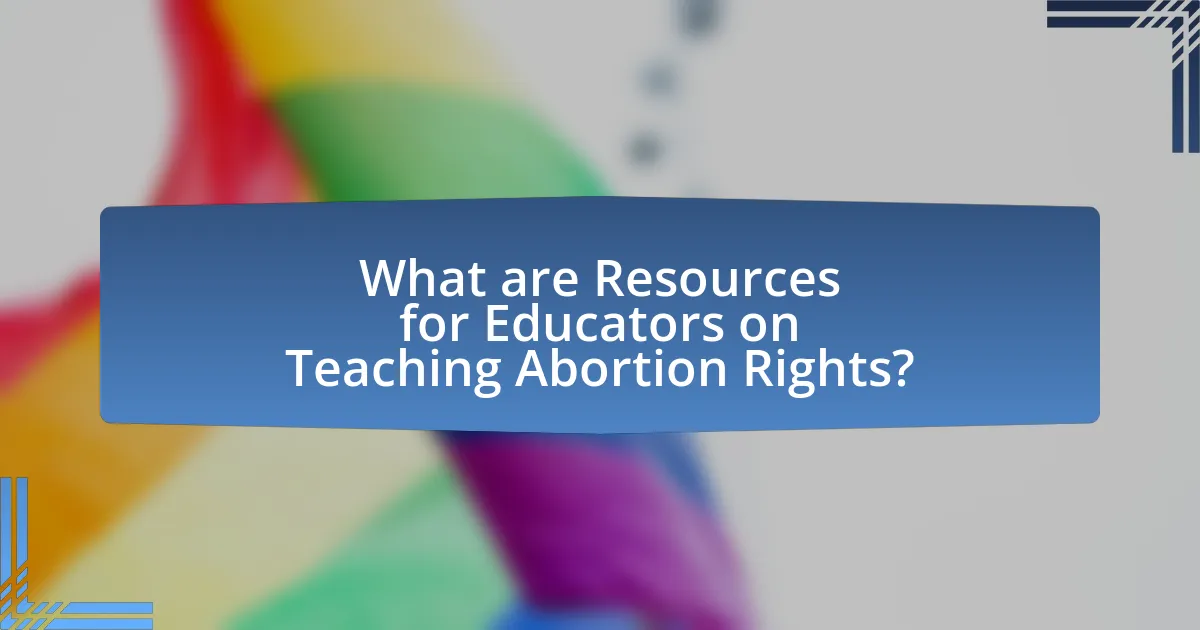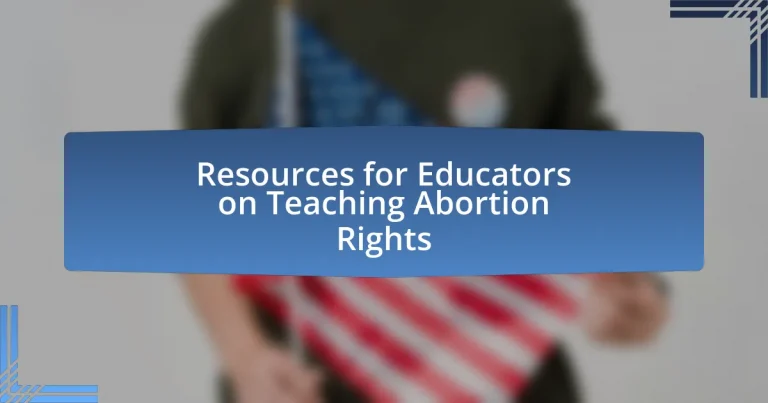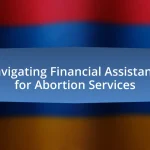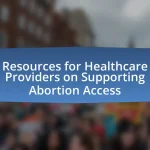The article focuses on resources available for educators teaching abortion rights, highlighting comprehensive guides, lesson plans, and online platforms that provide accurate information and effective teaching strategies. Key resources include the “Abortion Rights Toolkit” from the Center for Reproductive Rights and the “Teaching About Abortion” resource from the National Abortion Federation. The article emphasizes the importance of teaching abortion rights to empower students with knowledge about their reproductive health and legal rights, while also addressing historical context, societal attitudes, and effective teaching strategies. Additionally, it discusses the challenges educators face, common misconceptions, and best practices for facilitating respectful discussions on this sensitive topic.

What are Resources for Educators on Teaching Abortion Rights?
Resources for educators on teaching abortion rights include comprehensive guides, lesson plans, and online platforms that provide accurate information and teaching strategies. Notable resources are the “Abortion Rights Toolkit” by the Center for Reproductive Rights, which offers educational materials and legal context, and the “Teaching About Abortion” resource from the National Abortion Federation, which includes lesson plans and discussion guides. Additionally, organizations like Planned Parenthood provide workshops and online courses aimed at equipping educators with the knowledge and skills necessary to teach about abortion rights effectively. These resources are essential for fostering informed discussions and understanding of reproductive rights in educational settings.
Why is it important for educators to teach about abortion rights?
It is important for educators to teach about abortion rights because it empowers students with knowledge about their reproductive health and legal rights. Understanding abortion rights fosters critical thinking and informed decision-making among students, enabling them to navigate complex social and ethical issues. Research indicates that comprehensive sex education, which includes discussions on abortion, leads to better health outcomes and reduces stigma associated with reproductive choices. For instance, a study published in the Journal of Adolescent Health found that students who received comprehensive sexual education were more likely to understand their rights and access necessary health services.
What historical context should educators understand regarding abortion rights?
Educators should understand that abortion rights in the United States have evolved significantly since the early 20th century, particularly with the landmark Supreme Court decision in Roe v. Wade in 1973, which legalized abortion nationwide. This ruling was influenced by a growing movement advocating for women’s reproductive rights, which gained momentum in the 1960s and 1970s, highlighting issues of bodily autonomy and gender equality. Prior to Roe v. Wade, many states had restrictive laws that criminalized abortion, reflecting societal norms that prioritized traditional family structures and limited women’s rights. The historical context also includes subsequent legal challenges and shifts, such as the 1992 case of Planned Parenthood v. Casey, which upheld Roe but allowed states to impose certain restrictions. Understanding this trajectory is crucial for educators to convey the complexities of abortion rights and the ongoing debates surrounding them.
How do societal attitudes towards abortion influence educational approaches?
Societal attitudes towards abortion significantly influence educational approaches by shaping the content, tone, and accessibility of information provided in educational settings. For instance, in regions where abortion is viewed negatively, educational curricula may emphasize abstinence and discourage discussions about reproductive rights, limiting students’ understanding of their options. Conversely, in areas where abortion is accepted, educational programs often include comprehensive sex education that covers reproductive health, including abortion rights, thereby equipping students with factual knowledge and critical thinking skills. Research indicates that states with more progressive attitudes towards abortion tend to implement more inclusive sex education policies, as seen in the Guttmacher Institute’s findings, which highlight the correlation between state policies and educational content regarding reproductive health.
What types of resources are available for educators?
Educators have access to various resources for teaching abortion rights, including curriculum guides, lesson plans, online courses, and professional development workshops. These resources are designed to provide educators with accurate information, teaching strategies, and support materials to effectively address the topic of abortion rights in the classroom. For example, organizations like the Guttmacher Institute offer research-based materials and data on reproductive health, while the National Abortion Federation provides educational resources and training for educators. Additionally, platforms such as Teaching Tolerance offer lesson plans that incorporate discussions on social justice, including reproductive rights, ensuring that educators can engage students in meaningful conversations about the topic.
What are the key categories of resources for teaching abortion rights?
The key categories of resources for teaching abortion rights include educational materials, legal frameworks, advocacy organizations, and multimedia resources. Educational materials encompass textbooks, lesson plans, and curricula that provide factual information about abortion rights and reproductive health. Legal frameworks consist of documents outlining laws and regulations regarding abortion, such as court cases and legislative texts, which help educators explain the legal context. Advocacy organizations, like Planned Parenthood and the Guttmacher Institute, offer resources, training, and support for educators to effectively teach about abortion rights. Multimedia resources include videos, podcasts, and online platforms that present diverse perspectives and real-life stories related to abortion, enhancing engagement and understanding.
How can educators access these resources effectively?
Educators can access resources on teaching abortion rights effectively by utilizing online databases, educational websites, and professional organizations dedicated to reproductive health education. These platforms often provide curated materials, lesson plans, and research articles that are specifically designed for educators. For instance, organizations like the Guttmacher Institute and Planned Parenthood offer comprehensive resources that include statistics, educational guides, and policy information relevant to abortion rights. Additionally, educators can participate in webinars and workshops hosted by these organizations to enhance their understanding and teaching strategies regarding the topic.
How can educators integrate abortion rights into their curriculum?
Educators can integrate abortion rights into their curriculum by incorporating comprehensive discussions on reproductive health, legal frameworks, and historical context surrounding abortion. This can be achieved through lesson plans that include case studies, current events, and debates that highlight the implications of abortion rights on individual autonomy and public policy. For instance, educators can utilize resources from organizations like the Guttmacher Institute, which provides data and analysis on reproductive health issues, to inform students about the legal landscape and social movements related to abortion rights. Additionally, including perspectives from various stakeholders, such as healthcare professionals, legal experts, and activists, can enrich students’ understanding of the complexities surrounding the topic.
What teaching strategies are most effective for discussing abortion rights?
Effective teaching strategies for discussing abortion rights include fostering open dialogue, utilizing evidence-based resources, and incorporating diverse perspectives. Open dialogue encourages students to express their views and ask questions, creating a safe environment for discussion. Evidence-based resources, such as statistics from the Guttmacher Institute, provide factual context and enhance understanding of the complexities surrounding abortion rights. Incorporating diverse perspectives, including legal, ethical, and personal narratives, allows students to grasp the multifaceted nature of the issue, promoting critical thinking and empathy. These strategies collectively support a comprehensive educational approach to abortion rights.
How can educators create a safe space for discussions on abortion rights?
Educators can create a safe space for discussions on abortion rights by establishing ground rules that promote respect and confidentiality among participants. This approach encourages open dialogue while ensuring that all voices are heard without judgment. Research indicates that creating a supportive environment, where students feel comfortable expressing their views, significantly enhances engagement and learning outcomes. For instance, a study published in the Journal of Educational Psychology found that classrooms fostering a sense of belonging lead to increased participation in sensitive topics. Additionally, educators should provide resources that present diverse perspectives on abortion rights, allowing students to explore the subject comprehensively and critically.
What challenges do educators face when teaching about abortion rights?
Educators face significant challenges when teaching about abortion rights, primarily due to the polarized nature of the topic. This polarization often leads to strong emotional responses from students and parents, creating a contentious classroom environment. Additionally, educators may encounter legal restrictions and institutional policies that limit discussions on abortion, particularly in certain states or school districts. For instance, some states have enacted laws that restrict how educators can address reproductive health topics, which complicates the delivery of comprehensive education. Furthermore, a lack of training and resources on the subject can hinder educators’ ability to present balanced and factual information, making it difficult to foster informed discussions.
How can educators address potential pushback from students or parents?
Educators can address potential pushback from students or parents by fostering open communication and providing clear, factual information about abortion rights. Engaging in dialogue allows educators to understand concerns and misconceptions, which can be addressed through evidence-based discussions. For instance, presenting data from reputable sources, such as the Guttmacher Institute, which reports that comprehensive sex education reduces rates of unintended pregnancies, can help alleviate fears. Additionally, offering resources for further reading and creating a safe environment for questions can empower both students and parents to engage constructively with the topic.
What are common misconceptions about abortion rights that educators should clarify?
Common misconceptions about abortion rights include the belief that abortion is always used as a form of contraception, that it poses significant mental health risks, and that it is a recent phenomenon in society. Educators should clarify that research indicates the majority of individuals seeking abortions do so due to socio-economic factors, not as a primary method of birth control. Furthermore, studies, including those published in the American Psychological Association, show that the vast majority of women do not experience long-term mental health issues following an abortion. Lastly, abortion has been a part of reproductive health care for centuries, with historical records indicating its practice long before modern legislation.
How can educators stay informed about current developments in abortion rights?
Educators can stay informed about current developments in abortion rights by regularly consulting reputable news sources, legal databases, and advocacy organizations focused on reproductive health. For instance, organizations like the Guttmacher Institute and Planned Parenthood provide updates on legislation and policy changes, while legal databases such as Westlaw offer access to case law and legal analyses. Additionally, subscribing to newsletters from these organizations can ensure timely information delivery. Research indicates that staying updated through these channels enhances educators’ understanding of the evolving landscape of abortion rights, which is crucial for informed teaching and discussion in educational settings.
What are reliable sources for updates on abortion rights legislation?
Reliable sources for updates on abortion rights legislation include government websites, reputable news organizations, and advocacy groups. Government websites such as the U.S. Congress and state legislative sites provide official information on proposed and enacted laws. Reputable news organizations like The New York Times and NPR offer in-depth reporting and analysis on legislative changes. Advocacy groups such as the Guttmacher Institute and Planned Parenthood publish research and updates on abortion rights, reflecting current trends and legal developments. These sources are recognized for their accuracy and reliability in reporting on this critical issue.
How can professional development enhance educators’ understanding of abortion rights?
Professional development can enhance educators’ understanding of abortion rights by providing them with updated knowledge, diverse perspectives, and effective teaching strategies. Through workshops, seminars, and training sessions, educators can learn about the historical context, legal frameworks, and current debates surrounding abortion rights, which are essential for informed discussions in the classroom. For instance, programs that include expert speakers or access to legal resources can clarify misconceptions and present factual information, enabling educators to teach the topic accurately. Additionally, professional development can foster critical thinking and empathy by exposing educators to various viewpoints, thus preparing them to address sensitive issues related to abortion rights in a respectful and informed manner.
What best practices should educators follow when teaching about abortion rights?
Educators should adopt a balanced and fact-based approach when teaching about abortion rights. This includes presenting accurate information about the legal, medical, and ethical aspects of abortion, ensuring that students understand the historical context and current laws, such as Roe v. Wade and its implications. Additionally, educators should create a safe and respectful environment for discussion, encouraging diverse viewpoints while emphasizing empathy and critical thinking. Research indicates that comprehensive sex education, which includes discussions on abortion, leads to better understanding and informed decision-making among students. For instance, studies show that states with comprehensive sex education have lower rates of unintended pregnancies and abortions.
How can educators ensure they present balanced perspectives on abortion rights?
Educators can ensure they present balanced perspectives on abortion rights by incorporating diverse viewpoints and evidence-based information into their curriculum. This involves including materials that represent both pro-choice and pro-life arguments, ensuring that students are exposed to a range of opinions and the reasoning behind them. For instance, educators can utilize resources from organizations like the Guttmacher Institute, which provides comprehensive data on reproductive health, and the American Civil Liberties Union, which offers insights into legal rights related to abortion. By presenting statistics, historical context, and ethical considerations from multiple angles, educators can foster critical thinking and informed discussions among students.
What resources can help educators facilitate respectful discussions on abortion rights?
Educators can utilize resources such as the Guttmacher Institute’s research and educational materials, which provide evidence-based information on abortion rights and reproductive health. These resources include comprehensive reports, fact sheets, and policy analyses that help educators present factual data and diverse perspectives. Additionally, the National Abortion Federation offers training programs and discussion guides aimed at fostering respectful dialogue about abortion. These materials emphasize empathy, understanding, and critical thinking, equipping educators to navigate sensitive conversations effectively.


